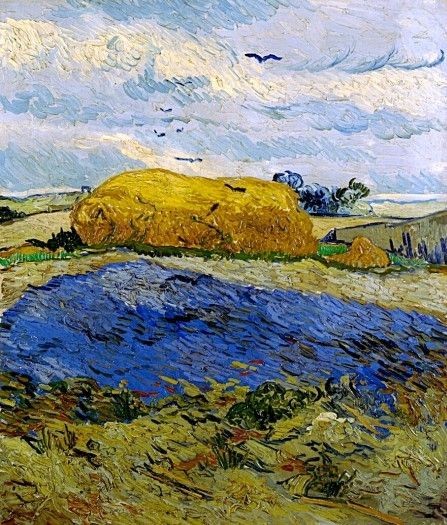Here's Why Van Gogh's Paintings are Fading
| Marco Foronda | | Mar 11, 2015 12:04 PM EDT |
(Photo : wikipedia.org) Wheat Stack Under Clouded Sky, Vincent van Gogh,1890, at the Kröller-Müller Museum in The Netherlands.
Vincent van Gogh's paintings aren't quite what they used to be.
The paintings are fading. Studies find the yellows are turning brown. The color red also poses problems.
Researchers are now moving closer to finding out why the paint in van Gogh's masterpieces is fading. It's because van Gogh preferred to use a pigment known as red lead.
Like Us on Facebook
Red lead is most familiar to us as orange-red rustproof paint. Artists have treasured the brilliant color of this pigment for their paintings since ancient times. Various ageing processes cause discoloration of the saturated hue over time.
A team headed by Koen Janssens at the University of Antwerp has been able to further clarify the degradation process of red lead that causes this bleaching of the color. The researchers examined a microscopically small sample of van Gogh's "Wheat Stack under a Cloudy Sky," an oil on canvas, using the micro/nanofocus beamline P06 of PETRA III.
Located in Germany, PETRA III is the most brilliant storage-ring-based X-ray radiation source in the world.
Researchers made use of X-ray powder diffraction mapping and tomography techniques to determine the distribution of different crystalline compounds within the sample with very high spatial resolution and specificity. Their methods resulted in a depth profile of the sample's composition without cutting it open in contrast to conventional X-ray crystallographic methods.
They found the red lead is covered in a "degradation product." One chemical may be the culprit: plumbonacrite.
It's causing a chemical buildup when light is shone upon it. The researchers say plumbonacrite has never been reported "in a painting dating from before the mid 20th century."
TagsHere's Why Van Gogh's Paintings are Fading, Van Gogh's Paintings are Fading, Van Gogh, painting, Vincent van Gogh, Van Gogh's painting, Wheat Stack under a Cloudy Sky, color red, Red lead, Kroller Muller Museum
©2015 Chinatopix All rights reserved. Do not reproduce without permission
EDITOR'S PICKS
-

Did the Trump administration just announce plans for a trade war with ‘hostile’ China and Russia?
-

US Senate passes Taiwan travel bill slammed by China
-

As Yan Sihong’s family grieves, here are other Chinese students who went missing abroad. Some have never been found
-

Beijing blasts Western critics who ‘smear China’ with the term sharp power
-

China Envoy Seeks to Defuse Tensions With U.S. as a Trade War Brews
-

Singapore's Deputy PM Provides Bitcoin Vote of Confidence Amid China's Blanket Bans
-

China warns investors over risks in overseas virtual currency trading
-

Chinese government most trustworthy: survey
-

Kashima Antlers On Course For Back-To-Back Titles
MOST POPULAR
LATEST NEWS
Zhou Yongkang: China's Former Security Chief Sentenced to Life in Prison

China's former Chief of the Ministry of Public Security, Zhou Yongkang, has been given a life sentence after he was found guilty of abusing his office, bribery and deliberately ... Full Article
TRENDING STORY

China Pork Prices Expected to Stabilize As The Supplies Recover

Elephone P9000 Smartphone is now on Sale on Amazon India

There's a Big Chance Cliffhangers Won't Still Be Resolved When Grey's Anatomy Season 13 Returns

Supreme Court Ruled on Samsung vs Apple Dispute for Patent Infringement

Microsoft Surface Pro 5 Rumors and Release Date: What is the Latest?










